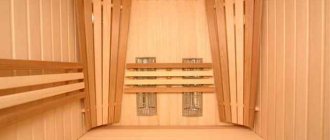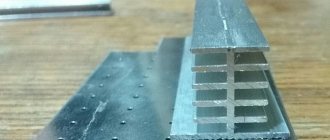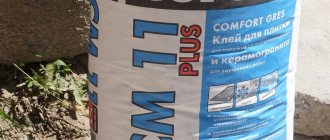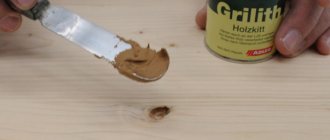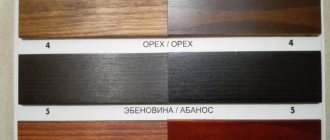There is a lot of information on our website, it is scattered under certain headings, but sometimes the content overlaps, and then we invite you to follow the link and get acquainted with more voluminous material on a given topic. This article is devoted to the questions of how to paint or treat the inside of a steam room in a bathhouse. Here you will find a brief summary of the matter, and details in the article on interior coatings for baths.
Criterias of choice
For all its advantages, wood is susceptible to moisture. Over time, it dries out, darkens and begins to rot. Mold and microorganisms may appear on it. All this is true for normal external conditions. And in the steam room the conditions are extreme. Even in the dressing room there are no such impacts on the walls and floor. The influence of sudden changes in temperature and humidity in the steam room accelerates the destruction of wood. When exposed to high temperatures, conventional protective coatings can release harmful substances.
In addition, a steam room is not just a room in which a person is located. He remains there naked, his body in contact with wooden surfaces. And on some it even lies. This means that for shelves and benches you need to choose wood protection that will not be unpleasant upon contact.
Most often in the steam room they try to preserve the natural color of the wood, selecting species that look beautiful. But if you want to paint part of the steam room, then you need to take this into account when choosing an impregnation. Not every impregnation is suitable for subsequent painting.
Wood color after different impregnations Source elka-palka.ru
It is clear that it will not be possible to find the same impregnation for a bathhouse outside and inside. Even different parts of the steam room may require different protective equipment. Wood treatment in a steam room should be carried out with compounds adapted to its conditions. And the choice must be based on the following criteria:
- Which part of the steam room is the product intended for?
- Will it be primary impregnation of wood, or re-coating of a previously protected surface?
- Method of applying a protective substance to a wooden surface - with a brush, roller or spray
- Are there plans to further paint the impregnated wood?
Mode of application
"Neomid" is a ready-made composition that does not require dilution. It must be mixed well before use. Apply the varnish evenly to a clean and dry wood surface using a brush, roller or spray gun in 2 or 3 layers. Work with the drug can be carried out at an air temperature of at least +5 °C. After finishing painting, the instruments must be immediately washed with water. After applying the first layer, it is recommended to sand the surface and clean it of any dust that has formed, which will improve its appearance.
The drying period for the varnish to touch is one hour (at an air temperature of +20 ° C and a relative humidity of 65%). The second layer can be applied no earlier than after 3 hours. The surface is ready for use after 3 days.
The average consumption of this product when applied in a single layer is approximately one liter per 7-10 square meters. m (depending on the surface being treated).
Ceiling
Perhaps the least requirements are placed on this part of the steam room. It is exposed only to the temperature effects of steam. Water almost never reaches it. Therefore, it can simply be coated with a specialized bath varnish.
The ceiling in the bathhouse must be reliably protected from dampness and temperature Source eco-ceiling.ru
See also: Catalog of companies that specialize in paints and varnishes.
Floor
Unlike the ceiling, all the water that is used in the steam room ends up on the floor. Therefore, the anti-water protection for floor boards must be very good. In addition to antibacterial and anti-water impregnation, it is advisable to cover the floor with a protective layer of varnish. But not every varnish is suitable for the floor. The protective layer should not be slippery. This is a must to protect the floor. Of course, the soles of your feet should not stick to the floor. Do not think that repeatedly coating the floor with varnish increases its safety. The thick layer of varnish cracks and water reaches the wood. In addition, the wood cannot “breathe” through such a coating and will still deteriorate.
When building a bathhouse, do not forget about impregnating the logs on which the floor boards are laid. This, of course, is not the inside of the bathhouse, and there are no special protection requirements for them. But if water gets to them, then sooner or later the floor inside the bathhouse itself will suffer, no matter how well it is protected.
Walls
Most of the impregnation for the bathhouse inside is spent on protecting the lining, which is usually used to line the walls. Therefore, you should not use impregnations and varnishes that, when heated, can release strong-smelling substances. And do not cover it with a protective layer that does not allow the wood to “breathe.”
Improper use of protective compounds can lead to the regular appearance of condensation on the walls of the bath Source synteko.in.ua
Shelves and benches
The shelves are the main part of the entire steam room, for which it is, in fact, built. Lying on it should be comfortable, pleasant and safe for health. Wood is a poor heat conductor, so even at high temperatures you won’t get burned by it. It’s another matter if it is covered with a protective film, which can cause a burn if touched. Therefore, it is not recommended to use paints or varnishes for it. It is better to apply a special impregnation for the bath. Often such impregnations are wax-based.
The requirements for the safety and convenience of the surface of shelves and benches are so high that there are bathhouse lovers who believe that wood should be natural for them and not covered with anything at all. But this is still suitable for small bathhouses, where simple shelves can be replaced. And when real furniture masterpieces are built, it is better to find a high-quality composition and ensure their durability.
It’s not enough to create beauty – you also need to protect it Source m.yukle.mobi
Safety regulations
Despite the fact that it would seem that there may be threats with the usual coating of a surface with varnish, they still exist.
Let's study the basic rules that need to be followed:
- Protect the skin of your hands and face - such substances contain many chemical elements. When spraying varnish, a lot of toxic substances are released into the room. In case of contact with human skin, there is a risk of burns.
- Use a respirator - toxic substances can enter the respiratory tract, which can also cause irreversible harm to a person.
- Wear glasses - if chemical residues get on the mucous membrane of your eyes, they can cause a burn.
If paint and varnish material does end up somewhere, follow the following instructions:
- Rinse the splashed area. If you find deep damage, immediately seek medical help from specialists.
- If you inhale a toxic substance, you must immediately leave the room for fresh air and try to cough. Be sure to rinse your nose. If you start to feel unwell or experience pain in the lungs, dizziness and lack of oxygen, immediately call an ambulance and seek help from specialists.
Protective compounds and their properties
For the sake of order, it is necessary to mention such a remedy as drying oil, which used to cover all the insides in the bathhouse. It is still used today, but it should not be used in a steam room. It will be cheap, but cheerful. In terms of protective properties, this is yesterday, and the smell from it when heated well is not pleasant.
Water-dispersed impregnations
They are made on a water basis, so they penetrate deeply into the wood structure. They are resistant to high temperatures, do not contain active chemical components and do not emit any harmful compounds when heated. Modern water impregnations contain antibacterial components. Available both colorless and with added dyes.
The disadvantage is their fragility. Over time, under the influence of water, they are washed out of the wood, so the impregnation must be renewed every two years.
Oil impregnations and varnishes
They impregnate and protect wood well from moisture, forming a film. But their inherent smell is a significant drawback. Therefore, they must be used with caution in the steam room. They are quite suitable for external impregnation and for protecting wood in the dressing room.
The varnish preserves the appearance of the wood, giving it a mysterious shine Source freepatriot.club
Acrylic based varnishes
Acrylic varnish for baths inside is considered safe. A modern product made from polyacrylates and organic solvents. Environmentally friendly and more durable than conventional water-dispersed products. Acrylic varnishes produced for baths and saunas necessarily contain antifungal components.
Water-based polyurethane varnish
Combines the advantages of water-dispersed and alkyd varnishes. It appeared on the market relatively recently, so it should be treated with caution, as with any new product. And its price is quite high.
Wax-based impregnations
Wax, like drying oil, has long been used to protect and add shine to wooden surfaces. Nowadays purely wax impregnations are almost never used. It is common practice to add wax to protective products based on other components.
In addition to protective products, special detergents are also produced for cleaning and bleaching wood. They are used both before applying protection and for washing dirty and darkened surfaces.
Why room treatment is so important
What is any steam room made of? That's right, made of wood. This material is not only environmentally friendly and healthy, but also easy to process, does not heat up, does not melt and is not subject to a number of other negative influences. However, wood is far from ideal and also has a number of problems. For example:
- darkening and loss of appearance;
- fungal development and mold;
- the appearance of cracks in wood followed by warping, etc.
All these troubles significantly reduce the service life of steam rooms. Therefore, if you use your sauna regularly and decide to save on high-quality varnish, the need for repairs will arise quite quickly. Just 2-3 years of intensive use will lead to the fact that all the lining in the bathhouse or sauna will have to be laid again. Although if you have the opportunity to do this or you use the room quite rarely, you can do without processing. But it’s better to spend extra money on varnish than to constantly close the steam room for repairs to replace the lining. So, we have figured out the importance of coverings for a bath or sauna, then we’ll talk about what to choose and how to make a choice.
Protective products for baths from different manufacturers
When processing wood inside a steam room, you should not experiment too much. You need to choose varnishes and impregnations made specifically for baths and saunas. Those who produce such products take into account the conditions and requirements for such premises.
The Finnish company Tikkurila is considered the leader of such products.
- Supi Saunasuoja – water-based impregnation with acrylic. Suitable for temperatures above 100 °C. A universal product for internal protection of steam rooms. Available in both a colorless version and a form suitable for tinting.
Impregnation Supi Saunasuoja Source marketut.ru
- Supi Laudesuoja – oil impregnation suitable for covering shelves
- Supi Saunavaha is a wax-based varnish. It is also considered universal and suitable for any bath surfaces.
Imported compounds have one drawback - the price. Domestic manufacturers provide cheaper products. Here are some designed specifically for bath conditions:
- Senezh sauna is an acrylate-based antiseptic to protect wood in saunas. Contains antimicrobial agents but is odorless.
- NEOMID 200 – antiseptic for wooden bath surfaces, including shelves and benches.
- NEOMID Sauna is a translucent acrylic-based varnish. For protecting and finishing wood in rooms with high humidity.
NEOMID Sauna varnish for baths Source gros-stroi.ru
How to treat the floor and shelves: varnish coatings in the steam room
How to paint the shelves in the bathhouse and can I use varnish for this? Of course it is possible. However, not any varnish coating is suitable for shelves, and even more so for a steam room in a bathhouse.
Important! The safest are acrylics from the company Tikkurila, already known to us.
They are made on a natural basis, and the finished product is heat-resistant, as well as a fairly large selection of colors and shades.
Before painting the lining in a bathhouse with varnish, you should familiarize yourself with its main advantages and disadvantages.
The advantages include:
- Antiseptic in the composition, so before coating it is not necessary to use additional substances to prepare the surface;
- The film formed on the varnished surface does not allow moisture to pass into the wood;
- The varnish coating does not lose its properties even at temperatures above 100 degrees;
- An abundance of colors from which you can choose the one that suits you, or use clear varnish.
You should apply the varnish responsibly.
The first step is to sand the surface of the shelf. This should be done starting with the largest nozzle and ending with the smallest.
Attention! The smallest nozzle performs a polishing role.
After polishing the shelves, wipe them with a damp cloth to remove any remaining sawdust, dust and dirt. Once the wood has dried, you can begin applying varnish. To do this you need to use a brush or roller.
It is very important to ensure that each part is coated with varnish. For hard-to-reach areas, we recommend using a thin brush or sponge
Information. In order not to make a mistake with the choice of colored varnish, it is first recommended to apply it to a small area in two layers to finally make sure that your choice is correct.
How to insulate
The floor is insulated during the construction stage, but this is already understandable. There is no way to insulate a torrential one with water draining under the bathhouse, but with the rest it’s already better.
Usually the insulation is placed on a layer of waterproofing (do not forget that it must be sealed and extend onto the walls). This can be polystyrene foam, expanded clay, or any other insulation material that can be poured on top with concrete and it will not lose its thermal insulation properties.
Also, for insulation, it is worth taking measures to seal the underground space - there should be no cracks or holes
But at the same time, if not necessary, then it is very desirable to have vents in the base, which should be closed during procedures, but in general are an important part of ventilation
There is another option for how to insulate the floor in a steam room. A concrete screed or a clay castle is not always made. Therefore, the insulation can also be placed on boards that are attached to the bottom of the logs. That is, the logs are first attached to the foundation frame or grillage, then the cranial bars are nailed, boards are attached to them, a water barrier in the form of a film is placed on them, for example, and the space between the logs is filled with insulation .
It would be worth putting another layer of water barrier on top of the insulation, because water can penetrate from above. Next is the subfloor, and whitewash on top of it. At the same time, we must not forget about the slopes leading to drainage. This option is shown in the picture above. It goes without saying that the drain pipe is brought directly to the level of the finished floor, and the entire wastewater drainage system is done during the laying of the foundation (if it is strip) or later (if it is columnar or pile).
Here's another option in the video below.
Well, the surest way to make walking on the floor comfortable in any frost is to install electric heating. Most often this is done if the owner is laying ceramic tiles.
More detailed material about floor insulation in a bathhouse is here.
